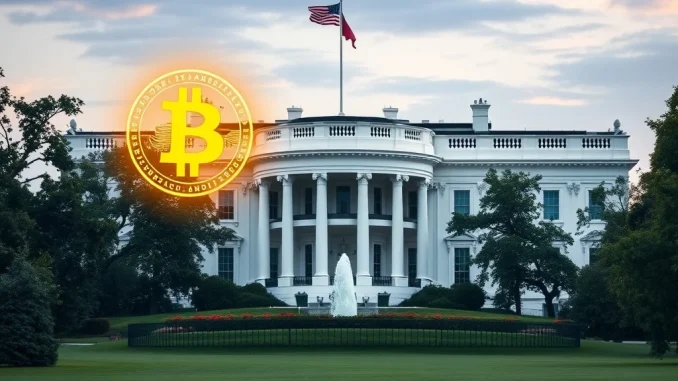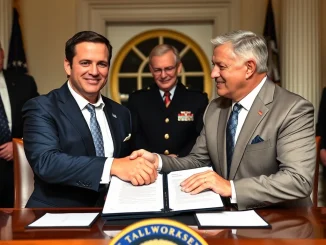
The crypto world is buzzing with anticipation as the White House prepares to unveil its long-awaited **Bitcoin Policy** report on July 30. This landmark document is poised to redefine the United States’ approach to digital assets, potentially setting a new standard for global financial leadership. For anyone invested in the future of decentralized finance, understanding the nuances of this report is crucial.
White House Crypto Policy: A Game-Changer for Digital Assets?
Spearheaded by Bo Hines, Executive Director of the President’s Digital Asset Advisory Council, and tech entrepreneur David Sacks, this comprehensive report is the culmination of a 180-day review by the President’s Working Group on Digital Assets. This cross-agency collaboration, involving key players like the Treasury, SEC, CFTC, and Commerce Department, underscores the administration’s serious commitment to tackling the complexities of the digital asset sector.
The report is expected to outline ambitious strategies aimed at maintaining U.S. dominance in digital finance. Key proposals include the potential creation of a Bitcoin reserve and expanded access to the Federal Reserve’s payment systems for blockchain firms. These are not minor tweaks; they represent potentially radical shifts in how the U.S. views and integrates cryptocurrencies into its financial fabric. The implications for the broader market and individual investors could be profound.
Unpacking the Bitcoin Policy: A Potential Reserve for the Nation?
One of the most talked-about proposals is the potential creation of a **Bitcoin Policy** reserve. This concept represents a significant departure from traditional treasury practices. The initiative explores the idea of leveraging seized or government-held Bitcoin to hedge against dollar volatility while preserving liquidity. Imagine a scenario where the U.S. government holds a strategic stash of Bitcoin, much like other nations hold gold reserves. This could fundamentally alter perceptions of Bitcoin’s role in global finance.
- Leveraging Existing Assets: The proposal considers using Bitcoin already in government possession, often acquired through law enforcement actions.
- Hedging Against Volatility: A Bitcoin reserve could serve as a hedge against fluctuations in the U.S. dollar, providing an alternative store of value.
- Global Precedent: While unique for the U.S., this mirrors strategies seen in countries like El Salvador, albeit with expected stricter compliance measures.
However, the mechanics remain undefined. Will the government actively trade these reserves, or will they be held long-term? The answers to these questions will significantly impact market dynamics and investor sentiment. The idea itself, however, signals a growing acceptance of Bitcoin as a legitimate financial asset at the highest levels of government.
Demystifying Federal Reserve Crypto Access: What It Means for Firms
Another pivotal aspect of the report is the proposal to grant digital asset firms direct access to the Fed’s payment infrastructure. This move could revolutionize how crypto firms operate, streamlining transactions and intensifying competition with traditional banks. Currently, many crypto businesses rely on traditional banks for basic financial services, often facing skepticism or outright denial. Direct access to the **Federal Reserve Crypto** system could:
- Reduce Friction: Enable faster, more efficient settlements for digital asset transactions.
- Foster Competition: Level the playing field between traditional financial institutions and innovative blockchain companies.
- Enhance Legitimacy: Signal a clear endorsement of crypto firms as legitimate participants in the financial system.
However, such access is likely to be contingent on stringent capital and auditing requirements. This could create a barrier to entry for smaller, emerging firms, potentially favoring established players with the resources to meet these demanding criteria. The balance between fostering innovation and ensuring financial stability will be a delicate one.
Securing US Digital Assets Leadership: Stablecoins vs. CBDCs
The document is also expected to advocate strongly for dollar-backed, privately issued stablecoins over central bank digital currencies (CBDCs). This stance reflects a preference for market-driven solutions and addresses significant privacy concerns associated with centralized control. For the future of **US Digital Assets**, this distinction is critical:
| Feature | Privately Issued Stablecoins (Preferred) | Central Bank Digital Currencies (CBDCs) (Rejected) |
|---|---|---|
| Issuance | Private entities (e.g., Tether, Circle) | Central bank (e.g., Federal Reserve) |
| Control | Decentralized/Distributed | Centralized |
| Privacy Concerns | Lower (depending on issuer) | Higher (potential for government surveillance) |
| Innovation Driver | Market-driven, competitive | Government-driven, potentially slower |
| Risk Profile | Tied to issuer’s reserves/compliance | Tied to government policy/control |
By rejecting the CBDC model, the administration emphasizes a commitment to privacy and avoids the risks associated with centralized digital currency control, a move that resonates with many in the crypto community.
The Tug-of-War: Navigating Crypto Regulation and Jurisdictional Conflicts
One of the persistent headaches for the crypto industry has been the ongoing jurisdictional disputes between the SEC and CFTC. These agencies have long debated whether most tokens qualify as securities or commodities, creating regulatory uncertainty. The working group’s proposed solution—a bifurcated oversight framework based on asset functionality—may not satisfy either side entirely.
This highlights the report’s inherent limitation: while it can propose frameworks, it cannot unilaterally resolve deep-seated conflicts between powerful regulatory bodies. The success of any new **Crypto Regulation** will hinge on effective collaboration and clear legislative mandates, which remain a significant challenge.
Political Currents and Institutional Adoption
The political context further complicates the report’s trajectory. A potential Trump administration has signaled support for minimizing regulatory barriers, a stance that aligns with broader calls for clarity and innovation. Initiatives like the Web3 banking alliance between WLFI and Vaulta underscore growing institutional crypto adoption, indicating that the industry is moving forward regardless of specific policy outcomes.
Notably, Trump-backed entities such as Trump Media & Technology Group have made substantial Bitcoin investments, signaling a convergence of political and market forces. These developments suggest that the drive for clearer regulation and greater integration of digital assets into the mainstream economy is gaining bipartisan traction, albeit with different philosophical approaches to oversight.
Market Implications and Future Outlook
The report’s immediate impact will hinge on its ability to balance innovation incentives with financial stability. The crypto market, with its approximately $260 billion size and expanding influence, is highly sensitive to regulatory signals. The recent approval and subsequent rescission of the Bitwise 10 Crypto Index Fund, for instance, illustrates the ongoing regulatory testing of crypto’s integration into traditional finance.
Market reactions to the July 30 release will reflect perceptions of the report’s effectiveness in fostering a competitive yet secure ecosystem. Clarity and a predictable regulatory environment are often seen as catalysts for growth and increased institutional investment.
Global Stage: US Leadership and International Relations
As the U.S. positions itself in a rapidly evolving global digital asset landscape, the White House’s approach could set precedents for cross-border cooperation. Recent U.S.-Japan trade agreements and reduced EU import tariffs hint at shifting economic diplomacy, but the U.S. stance on centralized versus decentralized frameworks remains a point of international interest.
The report’s recommendations on stablecoin governance, institutional participation, and infrastructure will be critical, given the sector’s global reach. How the U.S. navigates these complex issues will influence its standing as a leader in the digital financial ecosystem.
Conclusion
The July 30 release marks a pivotal moment in U.S. crypto policy. By addressing infrastructure gaps, regulatory alignment, and international collaboration, the report aims to solidify American leadership in a digital financial ecosystem. However, its success will depend on translating ambitious proposals into actionable policies that navigate political, regulatory, and market dynamics—a challenge that has defined the sector’s evolution. Investors, innovators, and policymakers alike will be watching closely to see if this monumental effort truly delivers on its promise.
Frequently Asked Questions (FAQs)
Q1: What is the primary goal of the White House’s new crypto policy report?
The primary goal is to redefine the U.S. approach to digital assets, maintain U.S. dominance in digital finance, and address the sector’s complexities through strategies like a potential Bitcoin reserve and expanded Fed access for blockchain firms.
Q2: How could a U.S. Bitcoin reserve impact the market?
A U.S. Bitcoin reserve could significantly legitimize Bitcoin as a financial asset, potentially increasing its stability and adoption. The impact would depend on whether the government actively trades or holds these reserves long-term, which remains undefined.
Q3: What are the benefits of granting crypto firms direct access to the Federal Reserve’s payment systems?
Direct access could streamline transactions, reduce operational friction for digital asset firms, and intensify competition with traditional banks. It would also enhance the legitimacy of crypto businesses within the broader financial system.
Q4: Why does the report favor privately issued stablecoins over CBDCs?
The report’s preference for privately issued, dollar-backed stablecoins stems from a desire to foster market-driven innovation and address privacy concerns associated with centralized control inherent in Central Bank Digital Currencies (CBDCs).
Q5: What are the main regulatory challenges the report aims to address?
The report seeks to navigate ongoing jurisdictional disputes between the SEC and CFTC regarding whether tokens are securities or commodities. It proposes a bifurcated oversight framework, though resolving these deep-seated conflicts remains a significant challenge.
Q6: How might political factors influence the implementation of this policy?
Political factors, such as a potential Trump administration’s stance on minimizing regulatory barriers, could influence the policy’s implementation. Growing institutional crypto adoption and bipartisan interest in clarity suggest a push for integration, regardless of specific political leanings.



